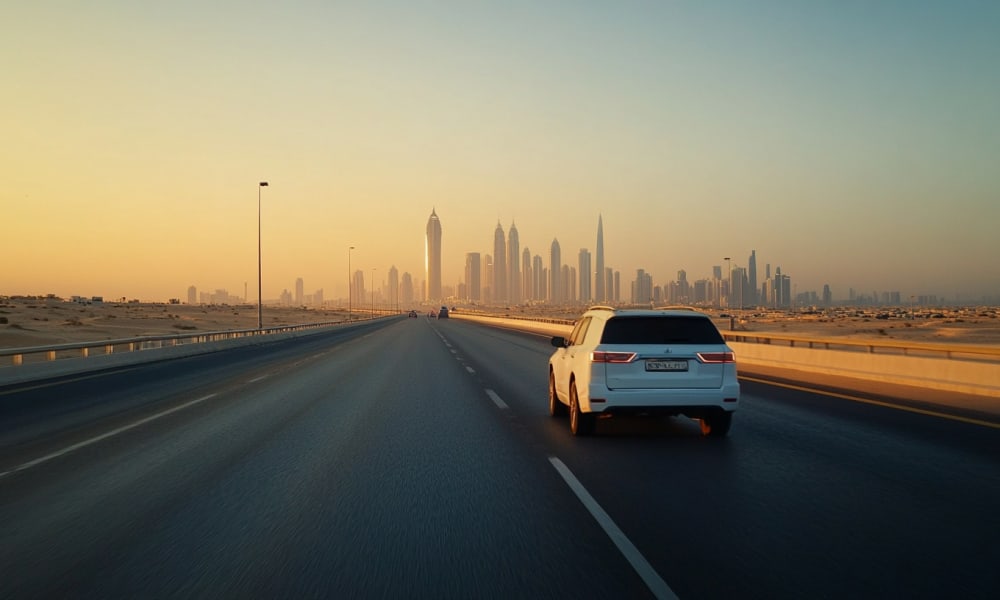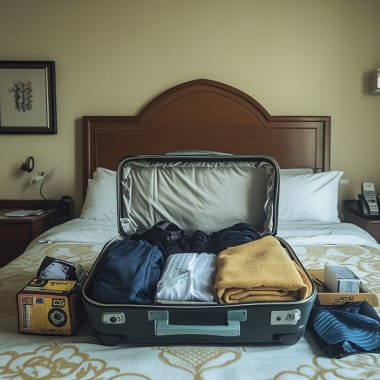
Transportation options on-site in Saudi Arabia
Mobility in transformation: How to travel safely, comfortably, and flexibly through modern Saudi Arabia.
Mobility in transformation: How to travel safely, comfortably, and flexibly through modern Saudi Arabia.
Saudi Arabia is a country of contrasts – between futuristic cities and endless desert landscapes, modern high-speed trains and traditional means of transportation. Those traveling individually through the kingdom face the question: How do I best get from A to B? The answer depends not only on the region but also on personal preferences and desired comfort. This overview shows you the transport options available on-site – from rental cars in metropolises to high-speed trains to sustainable alternatives – and what cultural and legal aspects you should consider.
The transport options in Saudi Arabia
Saudi Arabia is undergoing rapid change – including in the area of mobility. While the car remains the dominant mode of transport, bus and rail networks are continuously evolving, and new metro systems in cities like Riyadh and Mecca are setting standards. At the same time, domestic flights provide quick connections over long distances, and app-based ride services like Uber and Careem offer convenient solutions for short distances. For travelers who want to explore the country individually, this opens up numerous possibilities to move efficiently and flexibly.
However, you should familiarize yourself with the cultural and legal framework conditions before traveling. Gender separation in public transport, conservative dress codes, and clear legal regulations for road traffic are part of everyday life in Saudi Arabia. Those who respect these peculiarities and prepare well can travel safely, comfortably, and authentically in the country – whether by rental car, train, or ride service app.
Urban transport options in Riyadh and Jeddah
Whether you are traveling through futuristic Riyadh or exploring the coastal city of Jeddah – both metropolises offer a variety of mobility options that differ significantly in comfort, efficiency, and accessibility. While Riyadh sets new standards with its ultra-modern metro system, Jeddah boasts a dense network of ride services and classic means of transport. Here you will learn which options are best suited for which type of journey.
Car rentals in the city
A rental car offers maximum flexibility – especially if you are traveling individually or want to explore the surrounding area. In both cities, the road infrastructure is well-developed, and fuel prices remain comparatively low. In Riyadh and Jeddah, car rental stations can easily be found at airports and in city centers. Important: To rent a car, you need an international driver's license as well as a credit card. However, the dense city traffic can be challenging – defensive driving is advisable in any case.
Public transport
Riyadh has invested significantly in expanding public transport in recent years – with success: Since the end of 2024, one of the largest metro systems in the world has been in operation there. Six lines connect central neighborhoods, the airport, and important landmarks over more than 170 kilometers. The network is supplemented by a dense bus system with around 80 lines and nearly 3,000 stops – reliable, air-conditioned, and affordable.
In Jeddah, travelers still have to do without a metro system, but the bus network provides a solid alternative. While it is less efficient than that in Riyadh, it represents a good option for budget-conscious visitors who want to explore the city at their own pace.
App-based transport services
Taxis and ride services are widespread in both cities and offer many visitors the most convenient way to get around. Services like Uber and Careem enable easy and secure booking via an app – especially helpful for non-Arabic speakers. Prices are fair and significantly lower than European levels. For solo travelers or women, this option also provides a high level of comfort and safety, although cultural customs such as sitting in the back seat remain common.
Interregional transport options
Those exploring Saudi Arabia on their own will quickly notice: The distances between cities are large – but the country offers a wide range of modern, comfortable, and well-developed options to cover even longer distances safely and efficiently. Whether by train, airplane, or rental car – depending on your travel route, budget, and schedule, there is a suitable option for every type of trip.
Train system and recommended routes
The Saudi railway network is steadily growing and is becoming a real alternative to road and air travel. The best-known connection is the Haramain High-Speed Railway, which connects Mecca, Jeddah, and Medina with modern high-speed trains – especially a comfortable choice for pilgrimages and cultural routes. The north-south axis connects Riyadh via Al-Qassim and Hail with Sakaka, while the east-west connection between Riyadh and Dammam is particularly attractive for business travelers and city visitors.
The comfort of the trains is high, seat reservations can be easily made online, and new projects like the planned route between Kuwait and Riyadh further increase the significance of trains as a sustainable and reliable travel option.
Domestic flights in Saudi Arabia
Especially for journeys over several hundred kilometers, domestic flights offer a quick and convenient solution. Airlines Saudia and Flynas connect nearly all major cities in the country in a short time. Airports like those in Riyadh, Jeddah, Dammam, or Medina are modern and well-organized, and check-in and security processes run efficiently.
Those who book early can expect attractive fares – ideal for individual travelers with tight schedules. In remote regions that are not yet connected to the railway network, airplanes are often the best or only realistic option.
Road traffic safety and precautions
The Saudi road network comprises over 150,000 kilometers and is well-developed on major routes. For travel between cities, the car – whether private or rented – offers maximum flexibility. Especially in remote or desert-rich areas, an off-road vehicle is advisable. There are no tolls, and many routes are surprisingly lightly trafficked.
Nonetheless, caution is advised. Driving styles can often be aggressive, and traffic accidents are not uncommon. Defensive driving, good preparation, and the use of current maps and traffic information are essential. Those who want to travel safely should also pay attention to having enough fuel reserves – gas stations can be scarce outside urban areas and may not always accept international cards.
Cultural and legal peculiarities
Those who move around Saudi Arabia on their own should not only know the traffic rules but also respect the cultural and legal framework conditions. Public life in the kingdom is strongly influenced by religious norms and traditional values – and this is also reflected in behavior on the road. Good preparation helps to be confident and respectful while on the move.
Women in road traffic
Since 2018, women in Saudi Arabia have been officially allowed to drive – a significant social change. Nevertheless, the issue remains sensitive in parts of society. Women should therefore pay attention to conservative clothing while driving, ideally covering their shoulders and legs, and be reserved in their interactions with drivers, police officers, or workshop staff. In public transport, there are usually separate areas for men and women. In taxis or ridesharing services like Uber or Careem, it is common for women to sit in the back seat.
Interaction with drivers and locals
A respectful approach to drivers and the local population is essential. Avoid discussing religion or politics during the ride, and refrain from physical contact or overly personal questions. Public displays of affection – even among married couples – are not allowed. Do not photograph anyone without explicit permission, especially women, and be considerate of religious sentiments, such as during the fasting month of Ramadan. Eating, drinking, or smoking in public is taboo during the day in this time.
Legal requirements for foreign drivers
To drive a rental car, foreign visitors need an international driver's license in conjunction with their national document. The minimum age is generally 21, and for certain vehicle categories, it is 25. Driving is on the right side of the road, there is a 0.0 blood alcohol limit, and strict seat belt requirements apply – even in the back seat. The use of mobile phones while driving is prohibited and is punishable by hefty fines. Those involved in an accident should act cautiously and, if possible, contact their embassy, as liability can be assessed arbitrarily. Additionally, certain cities such as Mecca and Medina are closed to non-Muslims and must be detoured around.
Tourist and environmentally friendly transport options
Saudi Arabia is increasingly focusing on a modern, tourist-friendly, and sustainable transport infrastructure. Whether desert tours, city explorations, or cultural experiences – travelers now have a variety of options available to discover the kingdom comfortably and responsibly. Special offers and eco-friendly alternatives are particularly on the rise in large cities and culturally significant locations.
Special transport services for attractions
For visiting tourist highlights such as Al Ula, the old town of Jeddah (Al Balad), or the endless sand dunes of the Rub al-Khali, travelers have various organized transport solutions at their disposal. Popular are air-conditioned shuttle buses that operate between hotels and attractions, as well as guided tours that usually also include admission and local guides. In sacred cities like Mecca and Medina, special Umrah taxis and pilgrim shuttles complement the offerings.
Providers like SAPTCO also offer comfortable coaches connecting to cultural and scenic attractions throughout the country. For more remote destinations, all-terrain vehicles or private transfers are a good choice – especially in the desert or on adventure tours.
Environmentally friendly alternatives
Alongside tourist development, Saudi Arabia is pursuing ambitious sustainability goals. In cities like Riyadh, Mecca, and Jeddah, modern metro and bus networks are being established, which relieve individual traffic while promoting environmentally friendly transportation. The new bus network in Riyadh with nearly 3,000 stops or the comprehensive infrastructure in Mecca also facilitate environmentally friendly movement for tourists.
For travel between cities, modern train connections like the Haramain High-Speed Railway or the Riyadh-Dammam and North-South routes are convenient, fast, and significantly more environmentally friendly than domestic flights. With the goal of becoming climate-neutral by 2060, the kingdom is also investing in electric mobility and smart urban development – a progress from which visitors can also directly benefit.
Practical travel planning and future vision
Saudi Arabia is rapidly evolving into a modern travel destination with well-connected, comfortable, and increasingly sustainable mobility solutions. For individual travelers, this means: Good preparation significantly facilitates movement – and looking into the future is worthwhile.
Traffic conditions and information sources
Those wanting to explore the kingdom flexibly benefit from a variety of transport options – from rental cars to buses to high-speed trains. Official information sources like Visit Saudi, SAPTCO for bus travel, or the Saudi Railways Organization help with planning and booking. The General Authority of Civil Aviation also offers useful information on domestic flights and airports. For current traffic situations, route closures, and new infrastructure projects, a regular check of the Ministry of Transport's website is recommended.
App-based services like Uber and Careem provide real-time information on fares and availability, while international platforms like Tripadvisor provide experience reports and reviews. Additionally, diplomatic bodies like the Federal Foreign Office inform about safety aspects and changes in transport infrastructure.
Impact of Vision 2030 on transport
With Vision 2030, Saudi Arabia is pursuing ambitious plans to reshape its transport sector – towards smart, sustainable, and digitally connected systems. Flagship projects like NEOM and the futuristic city of The Line symbolize this development: a 170-kilometer-long, car-free zone with emission-free high-speed infrastructure and AI-controlled traffic management.
Modernization is also advancing in existing cities. The metro in Riyadh is already considered one of the most ambitious infrastructure projects in the world, and new lines in cities like Jeddah or Mecca are already in the planning stages. Intelligent traffic control, smart ticket systems, and digitally connected platforms will not only make mobility more efficient in the future but also make the travel experience more comfortable and sustainable.
Costs and budgeting
Price overview and savings tips
Whether you are driving a rental car through the desert, commuting by train between metropolises, or simply taking a taxi to the next attraction – Saudi Arabia offers travelers numerous ways to get around. And at prices that are often surprisingly affordable compared to international standards.
A simple ride on the metro or city bus costs around €1, while long-distance buses connect cities like Jeddah and Riyadh for about €11 per trip. For those who prefer to travel comfortably by train, the fare for the Riyadh-Dammam route starts at €21. Taxis begin with a starting fare of about €2.45 plus €1.55 per kilometer, while rental cars – depending on the type of vehicle – are available from about €35 per day. Domestic flights typically range between €50 and €150, depending on the route and booking time.
To use the travel budget efficiently, it is worth taking a close look at savings opportunities. In cities like Riyadh and Jeddah, time cards for buses and the metro offer attractive savings: Three days of unlimited travel costs only about €5, and a monthly ticket is about €35. Early booking also pays off for long-distance buses and trains – and those comparing prices online often benefit from special offers. Those traveling by rental car can save through carpooling, and for taxis, it is advisable to agree on the price before the ride, as not all vehicles are equipped with a meter.
With a daily budget of around €35, the country can be explored well and flexibly. Those seeking additional comfort – such as with SUVs, taxis, or occasional domestic flights – should plan around €50–65 per day for transport. This way, not only mobility is ensured, but also the budget remains balanced.
Discover the Orient with experts who have explored every corner themselves
Your dream holiday, tailor-made by experts.
We don't just know the Middle East from books, we visit the country several times a year to experience the culture, landscape and people first-hand.
From your first enquiry to your return home, we are there for you personally - by phone, email or WhatsApp, whenever you need us. Our trips are as unique as you are: individually planned and provided with exclusive privileges and high-quality arrangements that will make your trip unforgettable.
Experts for your Orient trip







